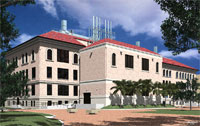 Location: Galveston, Texas
Location: Galveston, Texas
Owner: The University of Texas Medical Branch
Type of Project: Three-story, high-containment research addition adjacent to the existing Keiller Building
Architect: B2HK
General contractor: Vaughn Construction
Size: 12,000 gross square feet
Cost: $15.5 million
Construction time: Physical construction began in April 2002 and was completed in 2003
Dedication: November 17, 2003
Over the past two decades, The University of Texas Medical Branch
(UTMB) has developed a strong program in infectious disease research.
UTMB has an internationally recognized group of emerging infectious
disease investigators at a time when this subject is of critical public
health importance and interest.
In 1997, UTMB decided to construct a Biosafety Level 4 (BSL-4)
laboratory facility to safely handle and maintain infectious agents so
that UTMB researchers could continue making important discoveries on how
to combat some of the most deadly diseases known to man. This was well
before the anthrax attack of 2001, and before the decision in 2003 by
the National Institutes of Health (NIH) to partially fund construction
of the Galveston National Laboratory on the UTMB campus. Construction of
UTMB's BSL-4 laboratory was largely funded by a grant from The Sealy
and Smith Foundation of Galveston, a philanthropy solely dedicated to
benefiting UTMB, with additional support for the facility from NIH,
among other sources.
The BSL-4 laboratory was formally dedicated on November 17, 2003,
and was named the Robert E. Shope, MD, Laboratory in honor of Dr. Shope,
a world-renown virologist who was a member of the UTMB faculty until
his death from complications of idiopathic pulmonary fibrosis in early
2004. UTMB's Shope Lab, as it has come to be known, has been fully
operational since 2004. It is the first full-sized facility of its kind
in the nation to be located on a university campus.
BSL-4 is the highest biosafety rating for laboratories dealing with
highly contagious organisms. BSL-4 laboratories are designed to prevent
microbes from being released into the environment and to provide maximum
safety for the researchers inside. BSL-4 labs require some of the most
sophisticated architectural, engineering and construction techniques to
ensure the safety of both the scientists inside and the surrounding
community. Construction of the Shope Lab entailed a three-story addition
to the existing Keiller Building, as well as some renovation work
within the existing building infrastructure to accommodate the addition.
The combination of new work and renovation work resulted in an
additional 12,000 gross square feet of space. Often likened to a
submarine encased inside a giant bank vault, UTMB's Shope lab features
2,000 square feet of dedicated research space. The remaining 10,000
square feet of the facility contains support equipment designed to
capture and destroy any microbes before they can exit the structure.
While a BSL-4 may look like an ordinary building from the outside, the building itself is anything but ordinary. BSL-4 design features demand that:
- All seams, joints and doors are sealed to make the building
airtight. Windows cannot be opened, and air does not flow in or out
under the doors.
- Air is pumped in and out of the building through a sophisticated
filtration system to catch even the tiniest microscopic particles,
including bacteria and viruses.
- All air ducts are welded stainless steel and rigorously tested to ensure they are airtight.
- The laboratories are surrounded by "buffer" corridors to help protect them in the event of an accident or attack.
- Airlocks, fumigation chambers, disinfectant "dunk tanks" and waste
water treatment systems ensure that absolutely everything that leaves
the lab is decontaminated.
Interior safety features include:- Entries and exits with double-door airlocks.
- Regularly decontaminated work surfaces.
- Solid and liquid waste decontamination by heat sterilization,
gaseous sterilization, or liquid disinfection. Before it leaves the
facility, all waste meets or surpasses the environmental standards of
the local community.
- Airtight, pressurized suits with dedicated life-support systems
that include redundant breathing air compressors, alarms and emergency
backup air tanks, as well as a HEPA air filtration system.
- Work stations (called biosafety cabinets) that serve as
additional barriers. With their own inward-directed and HEPA-filtered
air systems, these cabinets are designed to prevent potentially
dangerous microbes from escaping.
As a testament to the Shope Lab's careful design and construction,
it survived Hurricane Ike with minimal damage after the storm made
landfall in Galveston on September 13, 2008. Hurricane Ike arrived as a
Category 2 storm on the Saffir-Simpson Scale, with sustained winds of
108 miles per hour and a storm surge of 13.5 feet.